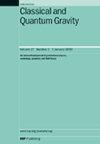A space-borne ultra-stable laser system with an excellent long-term frequency stability for gravitational wave detection
IF 3.6
3区 物理与天体物理
Q2 ASTRONOMY & ASTROPHYSICS
引用次数: 0
Abstract
Ultra-stable lasers are pivotal in various scientific applications, notably in space gravitational wave detection projects. We develop a space-borne ultra-stable laser system based on a home-made non-planar ring oscillator (NPRO) laser and an ultra-stable cavity laser stabilization system. The ultra-stable cavity is a vertically mounted 8 cm long cavity, with tunable zero-crossing temperature and low vibrational sensitivity. To make a cavity with any standard grade ultra-low expansion glass (ULE) material, and tune the zero-crossing temperature to the satellite platform temperature, we design three ultra-stable cavities with different configurations to unambiguously explore their thermal properties. The measurement results meet the design goals well, and the zero-crossing temperature of the cavity can be tuned from C to 16.0 °C. We measure the temperature fluctuation noise through modulation experiment, and it agrees well with the theoretical simulations. The vibrational sensitivities in three directions are measured to be around 10−11 /g–10−10 /g. The total weight of the system is 14.0 kg, with a volume of about 18 L, and the power dissipation of the electrical system is 18.6 W. Finally, the prototype of the space-borne laser shows a frequency instability of 9.5 at 0.2 s, and the frequency noise is measured to be 3.6 Hz/Hz1/2 at 6 mHz over three months, satisfying the mission targets of all current space gravitational wave detection programs.用于引力波探测的具有出色长期频率稳定性的空载超稳定激光系统
超稳定激光器在各种科学应用中,特别是在空间引力波探测项目中发挥着关键作用。我们开发了一种基于自制非平面环形振荡器(NPRO)激光器和超稳定腔激光稳定系统的星载超稳定激光系统。超稳定腔体是一个垂直安装的 8 厘米长的腔体,具有可调的过零温度和低振动灵敏度。为了用任何标准等级的超低膨胀玻璃(ULE)材料制作腔体,并将过零温度调至卫星平台温度,我们设计了三个不同结构的超稳定腔体,以明确探索其热特性。测量结果很好地满足了设计目标,空腔的零交叉温度可从 C 调至 16.0 °C。我们通过调制实验测量了温度波动噪声,结果与理论模拟十分吻合。测得三个方向的振动灵敏度约为 10-11 /g-10-10 /g。系统总重量为 14.0 千克,体积约为 18 升,电气系统耗散功率为 18.6 瓦。最后,空载激光器原型在 0.2 秒时的频率不稳定性为 9.5,三个月内测量到的 6 mHz 频率噪声为 3.6 Hz/Hz1/2,满足当前所有空间引力波探测计划的任务目标。
本文章由计算机程序翻译,如有差异,请以英文原文为准。
求助全文
约1分钟内获得全文
求助全文
来源期刊

Classical and Quantum Gravity
物理-天文与天体物理
CiteScore
7.00
自引率
8.60%
发文量
301
审稿时长
2-4 weeks
期刊介绍:
Classical and Quantum Gravity is an established journal for physicists, mathematicians and cosmologists in the fields of gravitation and the theory of spacetime. The journal is now the acknowledged world leader in classical relativity and all areas of quantum gravity.
文献相关原料
| 公司名称 | 产品信息 | 采购帮参考价格 |
|---|
 求助内容:
求助内容: 应助结果提醒方式:
应助结果提醒方式:


